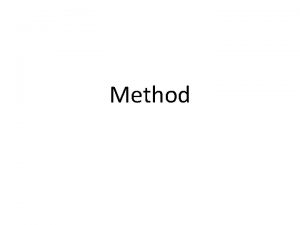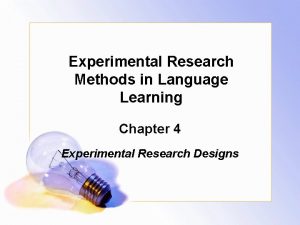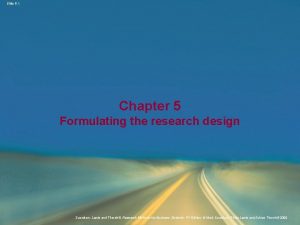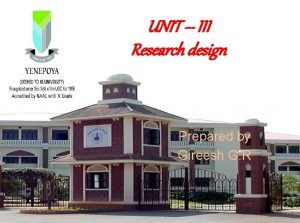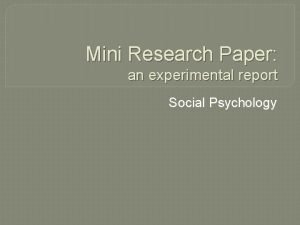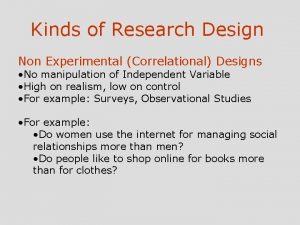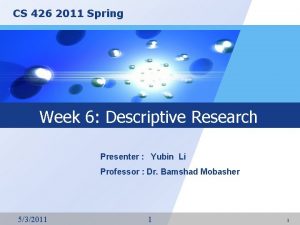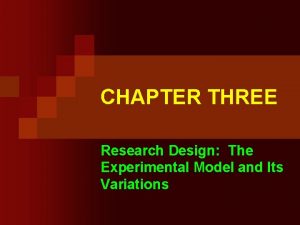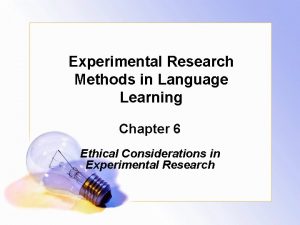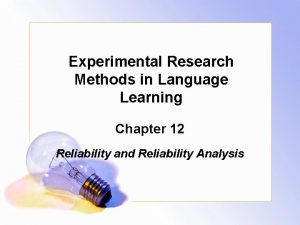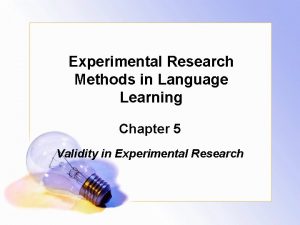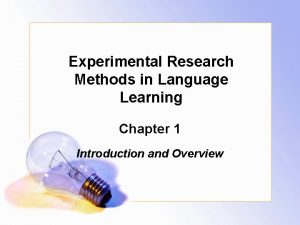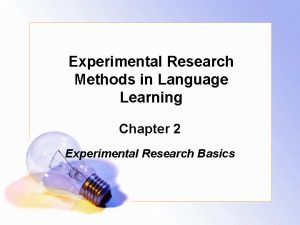Experimental Research Methods in Language Learning Chapter 4





















- Slides: 21

Experimental Research Methods in Language Learning Chapter 4 Experimental Research Designs

Leading Questions • Can you think of an example of an experimental research design for language learning research? What is it about? • Can you think of an example of a weak experimental design? What makes it weak? • Can you think of an example of a strong experimental design? What makes it strong?

What is a research design? • a systematic outline of the plans, stages, and strategies involved in each of the experimental research processes. • There at least four major experimental research designs: Ø pre-experimental Ø single-case Ø randomized experimental Ø quasi-experimental designs

Pre-experimental Designs • No random assignment • May be carried out in an intact or existing class • Many other variables (apart from the independent variable of interest) could play a role in influencing any findings • Good as or recommended as a pilot study (pretrial).

One-group Posttest-only Design

One-group Pretest-posttest Design

Posttest-only with Non-equivalent Groups design

Single-case Designs • aims to examine whether an intervention is effective for a particular individual in terms of improvements in learning or behaviors. • has a sample size of one participant. • no comparison group or random assignment • should not be confused with a case study. • an extension of the quasi-experimental, one-group time-series design.

A withdrawal single-case design

True Experimental Designs • 3 important aspects of true experimental designs: Manipulation of independent variables, randomization, and comparison groups • Manipulation techniques include: the presence or absence technique, the amount technique, and the type technique • Random assignment is a randomization technique used to place research participants into groups (e. g. , experimental or control groups.

True Experimental Designs • Comparison Groups: two or more equivalent groups with different conditions for the purpose of comparison. • The group which receives the treatment (i. e. , interaction activity) is called the experimental group. • The group that does not receive the treatment is called the control group.

Posttest-Only Control-Group Designs

Pretest-Posttest Control-Group Designs

Repeated-measures Design

Factorial Designs

Quasi-experimental Designs • The term ‘quasi’ is Latin for ‘almost’. • cannot do random assignments in quasiexperimental research • In real life situations, there are intact classes that cannot be rearranged. • Hence, researchers cannot achieve complete control over potential confounding variables that can be threats to the internal validity of the study

Pretest-Postest Nonrandomized Control Group Designs

One-group or Control-group Timeseries Designs

Methods for Random Assignment in Experimental Research • The Coin-toss Technique • The Block-randomized Technique • The Matching Technique v group matching technique v pair matching technique

Limitations of Experimental Research • Limitations due to language learners: Language learning is highly complex and multidimensional; learners’ background characteristics, psychological traits, and social settings • Limitations due to researchers: difficult to be fully objective in their observation

Discussion • Experimental research requires control over a situation in which research validity must be safeguarded. Why is it important to control variables in experimental research? • We have discussed three typical experimental techniques to manipulate an independent variable of interest (i. e. , the presence or absence technique, the amount technique, and the type technique). Which experimental designs discussed so far apply any of these techniques?
 Disadvantages of experimental research
Disadvantages of experimental research Research paradigm example
Research paradigm example Research instrument in experimental research
Research instrument in experimental research Experimental vs non experimental
Experimental vs non experimental Descriptive vs correlational vs experimental research
Descriptive vs correlational vs experimental research Experimental vs nonexperimental
Experimental vs nonexperimental Nonexperimental study
Nonexperimental study What is basic research
What is basic research Chapter 4 experimental research
Chapter 4 experimental research Research methods for business students chapter 5
Research methods for business students chapter 5 Cuadro comparativo de e-learning
Cuadro comparativo de e-learning A-wax pattern recognition
A-wax pattern recognition Solomon four group design
Solomon four group design Example of experiment research
Example of experiment research Types of quantitative research designs
Types of quantitative research designs Mini research report
Mini research report Contoh randomisasi
Contoh randomisasi Non-experimental/ descriptive design
Non-experimental/ descriptive design Random assignment vs selection
Random assignment vs selection Descriptive vs correlational vs experimental research
Descriptive vs correlational vs experimental research Quasi experimental design
Quasi experimental design Rival causal factors
Rival causal factors


